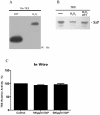Interaction between M-like protein and macrophage thioredoxin facilitates antiphagocytosis for Streptococcus equi ssp. zooepidemicus
- PMID: 22384152
- PMCID: PMC3288065
- DOI: 10.1371/journal.pone.0032099
Interaction between M-like protein and macrophage thioredoxin facilitates antiphagocytosis for Streptococcus equi ssp. zooepidemicus
Erratum in
- PLoS One. 2012;7(5): doi/10.1371/annotation/a1d856e3-285c-4728-b817-c030fb5ec20b
Abstract
Streptococcus equi ssp. zooepidemicus (S. zooepidemicus, S.z) is one of the common pathogens that can cause septicemia, meningitis, and mammitis in domesticated species. M-like protein (SzP) is an important virulence factor of S. zooepidemicus and contributes to bacterial infection and antiphagocytosis. The interaction between SzP of S. zooepidemicus and porcine thioredoxin (TRX) was identified by the yeast two-hybrid and further confirmed by co-immunoprecipitation. SzP interacted with both reduced and the oxidized forms of TRX without inhibiting TRX activity. Membrane anchored SzP was able to recruit TRX to the surface, which would facilitate the antiphagocytosis of the bacteria. Further experiments revealed that TRX regulated the alternative complement pathway by inhibiting C3 convertase activity and associating with factor H (FH). TRX alone inhibited C3 cleavage and C3a production, and the inhibitory effect was additive when FH was also present. TRX inhibited C3 deposition on the bacterial surface when it was recruited by SzP. These new findings indicated that S. zooepidemicus used SzP to recruit TRX and regulated the alternative complement pathways to evade the host immune phagocytosis.
Conflict of interest statement
Figures






Similar articles
-
Microarray analysis of the effect of Streptococcus equi subsp. zooepidemicus M-like protein in infecting porcine pulmonary alveolar macrophage.PLoS One. 2012;7(5):e36452. doi: 10.1371/journal.pone.0036452. Epub 2012 May 2. PLoS One. 2012. PMID: 22567158 Free PMC article.
-
Determination of the mimic epitope of the M-like protein adhesin in swine Streptococcus equi subsp. zooepidemicus.BMC Microbiol. 2008 Oct 7;8:170. doi: 10.1186/1471-2180-8-170. BMC Microbiol. 2008. PMID: 18840263 Free PMC article.
-
Prominent Binding of Human and Equine Fibrinogen to Streptococcus equi subsp. zooepidemicus Is Mediated by Specific SzM Types and Is a Distinct Phenotype of Zoonotic Isolates.Infect Immun. 2019 Dec 17;88(1):e00559-19. doi: 10.1128/IAI.00559-19. Print 2019 Dec 17. Infect Immun. 2019. PMID: 31636136 Free PMC article.
-
The pathogenic equine streptococci.Vet Res. 2004 Jul-Aug;35(4):397-409. doi: 10.1051/vetres:2004025. Vet Res. 2004. PMID: 15236673 Review.
-
The thioredoxin antioxidant system.Free Radic Biol Med. 2014 Jan;66:75-87. doi: 10.1016/j.freeradbiomed.2013.07.036. Epub 2013 Jul 27. Free Radic Biol Med. 2014. PMID: 23899494 Review.
Cited by
-
Citrus flavonoid extracts alter the profiling of rumen antibiotic resistance genes and virulence factors of dairy cows.Front Microbiol. 2023 Jun 9;14:1201262. doi: 10.3389/fmicb.2023.1201262. eCollection 2023. Front Microbiol. 2023. PMID: 37362928 Free PMC article.
-
Microarray analysis of the effect of Streptococcus equi subsp. zooepidemicus M-like protein in infecting porcine pulmonary alveolar macrophage.PLoS One. 2012;7(5):e36452. doi: 10.1371/journal.pone.0036452. Epub 2012 May 2. PLoS One. 2012. PMID: 22567158 Free PMC article.
-
A streptococcal Fic domain-containing protein disrupts blood-brain barrier integrity by activating moesin in endothelial cells.PLoS Pathog. 2019 May 9;15(5):e1007737. doi: 10.1371/journal.ppat.1007737. eCollection 2019 May. PLoS Pathog. 2019. PMID: 31071198 Free PMC article.
-
Transient Receptor Potential Canonical Channels 4 and 5 Mediate Escherichia coli-Derived Thioredoxin Effects in Lipopolysaccharide-Injected Mice.Oxid Med Cell Longev. 2018 Jun 10;2018:4904696. doi: 10.1155/2018/4904696. eCollection 2018. Oxid Med Cell Longev. 2018. PMID: 29983857 Free PMC article.
-
Functional analyses of complement convertases using C3 and C5-depleted sera.PLoS One. 2012;7(10):e47245. doi: 10.1371/journal.pone.0047245. Epub 2012 Oct 10. PLoS One. 2012. PMID: 23071769 Free PMC article.
References
-
- Eyre DW, J SK, Bowler IC, McBride SJ. Streptococcus equi subspecies zooepidemicus meningitis-a case report and review of the literature. Eur J Clin Microbiol Infect Dis 2010 - PubMed
-
- Abbott Y, Acke E, Khan S, Muldoon E, Markey B, et al. Zoonotic transmission of Streptococcus equi subsp. zooepidemicus from a dog to a handler. J Med Microbiol 2009 - PubMed
-
- Hornef MW, Wick MJ, Rhen M, Normark S. Bacterial strategies for overcoming host innate and adaptive immune responses. Nat Immunol. 2002;3:1033–1040. - PubMed
-
- Ernst JD. Bacterial inhibition of phagocytosis. Cell Microbiol. 2000;2:379–386. - PubMed
-
- Wibawan IW, Pasaribu FH, Utama IH, Abdulmawjood A, Lammler C. The role of hyaluronic acid capsular material of Streptococcus equi subsp. zooepidemicus in mediating adherence to HeLa cells and in resisting phagocytosis. Res Vet Sci. 1999;67:131–135. - PubMed
Publication types
MeSH terms
Substances
LinkOut - more resources
Full Text Sources
Miscellaneous

